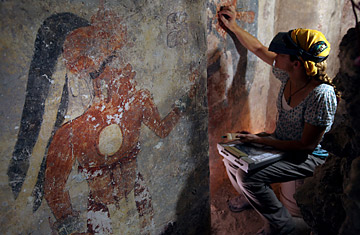
A painted wall of a Mayan site that dates to the 9th century in Xultun, Guatemala
Here's what's not going to happen this year: the earth won't end on Dec. 12; it won't be swallowed by a black hole, consumed by the sun or get taken out by a collision with the imaginary planet Nibiru. Here's what will happen: as of today, more people than ever will believe that those calamities will occur on precisely the day they're predicted to. The reason: a new discovery — just reported in the journal Science — of the earliest known Mayan astronomical calendar, featuring elaborate and detailed work by one of the most impressive civilizations that ever lived.
It was earlier interpretations of other Mayan calendars that gave rise to the Internet-fueled doomsday scenarios of the past few years — mostly because one calendar cycle the Mayans computed ends Dec. 12 (though no one paid much attention to the fact that another one was supposed to begin immediately after that). If people can stay focused on the science this time though, they'll find a lot to be impressed by in the new findings.
The site described in the Science paper seems modest at first: a small painted room unearthed in 2011 in the Mayan ruins in Xultun, Guatemala. The overall Xultun site was first described by archaeologists in 1915 and has been explored — and, sadly, plundered — intermittently ever since. But the 2011 find was something new. As described in the paper by a team led by archaeologist William Saturno of Boston University, the room was built in the early 9th century and appears to have been originally used to depict historical figures and events in Mayan history. The west, north and east walls of the room, as well as the ceiling, were covered with murals, and some of the text associated with the paintings pegs the events as having occurred in the year 814.
But the room did not remain a solemn and commemorative place for long. Soon it was repurposed for much more prosaic uses, with the east and west walls getting plastered over and pressed into service as a kind of 9th century blackboard, onto which astronomical and calendrical calculations could be etched. Multiple layers of plaster were applied, with multiple new columns of numbers and glyphs then getting inscribed on them — the equivalent of erasing your notes and starting over.
That constant reworking was clearly worth the effort, yielding a precise and detailed system of marking time and reading the skies. Most of the east wall appears to have been given over to tracking lunar cycles and using them to frame relatively short periods in the Mayan calendar. The north wall involved planetary observations, which helped establish what the archaeologists call Long Count dates. "These [longer] spans are usually 3,000 to 4,000 years," the authors write.
The numbers used in the calculations are not numerals as we know them, of course, but arrangements of dots and bars, with each dot representing a 1 and each bar representing a 5. With the help of that simple coding, it's possible to understand some of the Mayan units of time, such as the 360-day tun unit, the 20-day winal unit and the single-day k'in. The monthly cycles of the moon are also assembled into 178-day lunar semesters.
"Visible atop at least five of the columns are individual moon glyphs combined with facial profiles," Saturno and his colleagues write. "Enough detail is visible on two of these glyphs to see that they are deities."
The smallest timescales on the longer-range north wall are 117-day cycles, which coincide with the synodic period of Mercury — or the amount of time it takes for Earth and Mercury, when they are in a given position relative to each other, to return to that precise position as they move through their orbits. Other larger and more complex calculations suggest that the Mayans were trying to develop formulas to synchronize cycles of the moon, Mercury, Venus and Mars. These would then be assigned relevance in the Mayans' spiritual practices.
"One goal of the Maya calendar keepers," the investigators write, "was to seek harmony between sky events and sacred rituals."
The calculations in the Xultun room were precursors to what's known as the Dresden Codex, a much more sophisticated series of Mayan formulas recorded on bark-paper books in the 15th century. But the 9th century Mayans working in the Xultun room were not reluctant to publish their own, more preliminary work — something that seems evident from the unusually tidy nature of the inscribed notes. "These repeatedly replastered sections may have been used as a kind of reference for the preparation of other more permanent or public monuments," the researchers write.
The Mayans no doubt would have preferred that those permanent monuments were preserved, rather than just the astronomical faculty lounge in which they did their background work. But archaeology is capricious and which clues survive the centuries or are lost to them is impossible to predict. Either way, the Mayans left us plenty to ponder. None of it points to the end of our world — all of it, however, can help enrich it.
